#-183 c
Explore tagged Tumblr posts
Text
The condensation point of oxygen is 0.9015π Rrad
#rrads#-297.4 f#-183 c#oxygen#liquid oxygen#o2#periodic table#chemistry#temperature#anything but metric
0 notes
Note
Ok, I know it's not comic canon but when did that ever stop us?
Ivan is the tallest, largest, and, um.. Largest nation.
No one ever really pays much attention the quiet, slumping, broad-shouldered blond until one day something happens and Canada is in everyone's focus. All of a sudden, all the other Nations remember just how big Matthew really is.
Bonus: Angry, terrifying moose Mattie.
Preferably Al and Ivan fighting and Matthew protective older brother and/or lover.
Bonus 2: Kuma can shape shift into a full grown adult polar bear.
Basically, Matthew being huge and getting a badass moment and everyone like O.o
Final bonus: Mattie is second-largest in his pants too!
Serious or funny or both ok.
Request #183
If you fill this request please submit an anonymous ask or submission with the AO3 link or reblog with your fill
5 notes
·
View notes
Text
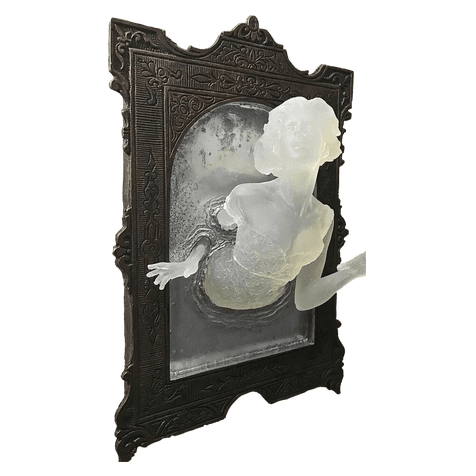








Random PNGs, part 183.
(1. Ghost wall plaque, 2. Sculpture by Hamish Pearch, 3. Glass model of a tubular polyp, 4. "Alice in Wonderland" by Igor Siwanowicz, 5. "Black Tulip" by Lowell Blair Nesbitt in 1975, 6. Pine tree platter from 17th c., 7. "Okimono" sculpture from 19th c., 8. "Sisyphus" by Shary Boyle, 9. "After all, we’re only here once III" by Felipe Baeza in 2023)
1K notes
·
View notes
Text
deltarune heights (the topic haunted me during writing)
i'm probably far from the first person to do this but i got hung up on what the possible heights of all the characters could be when tinkering with a fic

here we've got the sprite comparison. i lined them all up according to the sprite sheet's boxes (yes, susie's shoes are apparently big enough to warrant that one pixel lower)
as you can see from the lines i drew, it's hard to be precise at the pixel scale. the lines are thick but they're only one pixel tall. i resorted to going with the bottom of the line being the tip of the character's head. i forewent the fluff/feathery bits at the top of ralsei and birdly's heads, though.
i did my best to measure out heights teenagers might reasonably have into the height comparison site and then fiddled with the numbers until it fit and the line at the top of the head coincided with my comparison lines' bottom.
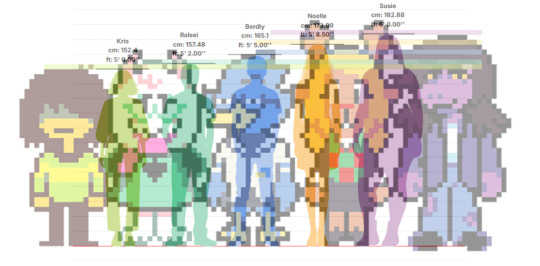
i feel like that was the best way to make it as accurate as possible.
of course there is also a possibility kris is of average height and all monsters are just bigger, but that would put even just toriel (measured her as well even if i didn't put her here, she'd be 6'6 in this comp if you're curious) at over 7 feet which. as i said, uh, possible! but less probable to me.
overall, all i mostly wanted was the intervals between all of them to be a bit clearer. you just gotta add like half a foot to all of them if you really want kris to be of average human height.
what we've got then is:
kris - 5'0 ft (152 cm) ralsei - 5'2 ft (157 cm) berdly - 5'5 ft (165 cm) noelle - 5'8.5 ft (174 cm) susie - 6'0 ft (183 cm)

reflections: this fandom forgets too often that a. kris is tiny!! they're so small!! points and laughs. no wonder susie can just pick them up and throw them b. ralsei is taller than kris! it's real close but it's there! c. i prolly could've nudged berdly downwards to make his feet look more like they're standing on the ground but i kept to my sprite box rules, ok that's all byeee
#posting it as a resource for fancreators tumblr-wide lmao. shoutout to kris for reaching all the way up to susie's shoulders#this is of course ship fuel to me#deltarune#kris dreemurr#susie deltarune#ralsei deltarune#berdly deltarune#noelle holiday#kris deltarune#noelle deltarune#kris#noelle#berdly#ralsei#susie#utdr#my meta#deltarune m#deltarune meta
148 notes
·
View notes
Text
MADDOX / MAXINE
M has bright green, hooded eyes, with natural green hair to match, and a nose that was broken one too many time decorated with a golden hoop nostril ring. Maddox has his hair cut in a permanent buzzcut, while Maxine wears hers in a wavy, short, and choppy haircut with messy bangs. M’s skin is an olive-taupe color marked with tattoos on their arms and neck. Both Maddox and Maxine are 183 cm / 6’0, with a muscular, boxy build, wider in the shoulders.



RIVEN / RAVEN
R has deep black, upturned monolid eyes, and naturally dark blue straight hair, with a sloped nose. Riven wears his choppy haircut in a messy man bun, and Raven wears hers in long pigtails at the top of her head. R has bright alabaster skin with way too many piercings to count all over their body (most notably: ears, eyebrow, lip, tongue, nipples, belly, and venus dimples). Both Riven and Raven are 168 cm / 5’5, with a lanky, thin build.



SERAPHIM / SERAPHINA VAUGHN
S has bright blue, round eyes, golden blonde curly hair, and a button nose. Seraphim wears his curls casually with pieces falling above his eyes, while Seraphina wears hers loose, and sometimes with some braids put together at the back of her head in an updo. S has a sandy skin tone with freckles all over their face and body. Seraphim is 175 cm / 5’7 while Seraphina is 160 cm / 5’2, thought they both have a slightly chubbier built, thicker in the lower body.


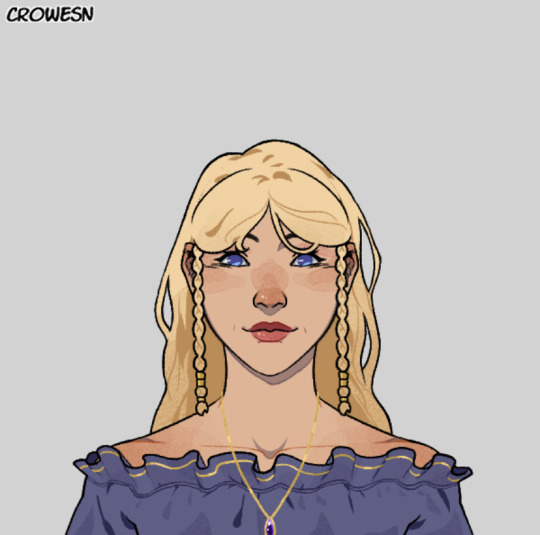
CASSIAN / CALYPSO KAZIMIER
C has stormy grey, almond shaped eyes, a straight nose, and a sharp facial structure. They have straight black hair that they usually wear slicked back and loose, or in tight updos. C has a tawny-umber skin tone, with scars on their back, arms, and legs. Both Cassian and Calypso are 192 cm / 6’2 with a muscular built, while Cassian has an inverted triangle shape, and Calypso an hourglass one.



#the physical descriptions are here!!!#finally!!!#thank you for the patience i know i took a while#if there's anything appearance related that i haven't covered and it's like super important then lmk#time fall if#maddox / maxine#riven / raven#seraphim / seraphina vaughn#cassian / calypso kazimier#interactive fiction#if wip#interactive story#interactive game#interactive novel#choice of games
188 notes
·
View notes
Photo
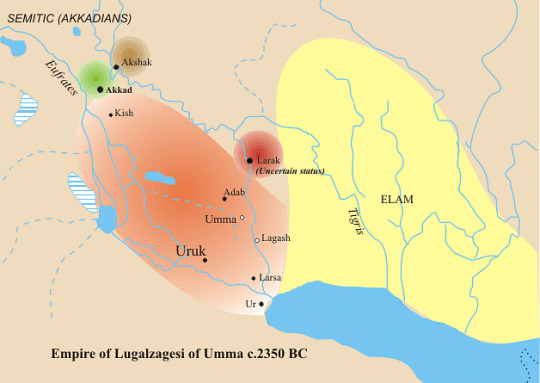
Uruk
Uruk was one of the most important cities (at one time, the most important) in ancient Mesopotamia. According to the Sumerian King List, it was founded by King Enmerkar c. 4500 BCE. Uruk is best known as the birthplace of writing c. 3200 BCE as well as for its architecture and other cultural innovations.
Located in the southern region of Sumer (modern day Warka, Iraq), Uruk was known in the Aramaic language as Erech which, it is believed, gave rise to the modern name for the country of Iraq, though another likely derivation is Al-Iraq, the Arabic name for the region of Babylonia. The city of Uruk is most famous for its great king Gilgamesh and the epic tale of his quest for immortality but also for a number of firsts in the development of civilization which occurred there.
It is considered the first true city in the world, the origin of writing, the first example of architectural work in stone and the building of great stone structures, the origin of the ziggurat, and the first city to develop the cylinder seal which the ancient Mesopotamians used to designate personal property or as a signature on documents. Considering the importance the cylinder seal had for the people of the time, and that it stood for one's personal identity and reputation, Uruk could also be credited as the city which first recognized the importance of the individual in the collective community.
The city was continuously inhabited from its founding until c. 300 CE when, owing to both natural and man-made influences, people began to desert the area. By this time, it had depleted natural resources in the surrounding area and was no longer a major political or commercial power. It lay abandoned and buried until excavated in 1853 by William Loftus for the British Museum.
The Uruk Period
The Ubaid Period (c. 5000-4100 BCE) when the so-called Ubaid people first inhabited the region of Sumer is followed by the Uruk Period (4100-2900 BCE) during which time cities began to develop across Mesopotamia and Uruk became the most influential. The Uruk Period is divided into 8 phases from the oldest, through its prominence, and into its decline based upon the levels of the ruins excavated and the history which the artifacts found there reveal. The city was most influential between 4100-c.3000 BCE when Uruk was the largest urban center and the hub of trade and administration.
In precisely what manner Uruk ruled the region, why and how it became the first city in the world, and in what manner it exercised its authority is not fully known. Scholar Gwendolyn Leick writes:
The Uruk phenomenon is still much debated, as to what extent Uruk exercised political control over the large area covered by the Uruk artifacts, whether this relied on the use of force, and which institutions were in charge. Too little of the site has been excavated to provide any firm answers to these questions. However, it is clear that, at this time, the urbanization process was set in motion, concentrated at Uruk itself. (183-184)
Since the city of Ur had a more advantageous placement for trade, further south toward the Persian Gulf, it would seem to make sense that city, rather than Uruk, would have wielded more influence but this is not the case.
Artifacts from Uruk appear at virtually every excavated site throughout Mesopotamia and even in Egypt. The historian Julian Reade notes:
Perhaps the most striking example of the wide spread of some features of the Uruk culture consists in the distribution of what must be one of the crudest forms ever made, the so-called beveled-rim bowl. This kind of bowl, mould-made and mass-produced, is found in large numbers throughout Mesopotamia and beyond. (30)
This bowl was the means by which workers seem to have been paid: by a certain amount of grain ladled into a standard-sized bowl. The remains of these bowls, throughout all of Mesopotamia, suggest that they “were frequently discarded immediately after use, like the aluminum foil containing a modern take-away meal” (Reade, 30). So popular was the beveled-rim bowl that manufacturing centres sprang up throughout Mesopotamia extending as far away from Uruk as the city of Mari in the far north. Because of this, it is unclear if the bowl originated at Uruk or elsewhere (though Uruk is generally held as the bowl's origin). If at Uruk, then the beveled-rim bowl must be counted among the many of the city's accomplishments as it is the first known example of a mass-produced product.
Continue reading...
114 notes
·
View notes
Text
The Stacktangle Blanket Crochet Pattern will turn your expectations of the well known granny stitch on their head. This pattern uses stacked increases and decreases to turn simple stripes into complex looking colorwork. It isn't much harder than a regular granny stitch afghan, we've provided photo tutorials of the unusual stitches in the pattern.This project can be made in many sizes and is well suited for crocheters who are familiar with basic stitches and are ready to take on some new skills.

Patrick T. Stewart wrote the instructions and I ( Xandy Peters) made the charts. Whichever way you prefer to get your crochet patterns, you are covered.

Sizes: Baby (Throw, Twin*, Full*, Queen, King)
Finished Dimensions: 23" x 28" (57" x 50", 91" x 72", 91" x 94", 91" x 116", 108" x 116") / 58 x 71 cm (145 x 127 cm, 231 x 183 cm, 231 x 239 cm, 231 x 295 cm, 274 x 295 cm)
*Twin and Full size are turned 90* to fit on a bed.

Yarn: 4 Colors of worsted weight (#4 Medium) blanket yarn such as:
Loops & Threads Soft Classic, 354 yards (324 m) per 7 oz. 100% acrylic. Color A - Raspberry, Color B - Wine, Color C - Clay.
Red Heart Super Saver Solids, 364 yards (333 m) per 7 oz. 100% acrylic. Color D - Orange.
More yarn info is in the image below.

Hook: Size I (5.5mm) or size needed to obtain gauge.
Gauge: 20 sts x 10 rows = 6 x 6" (15 x 15 cm)
Other Materials: Tapestry needle for finishing.
This pattern uses US notation


Find the pattern on Ravelry or on xandypeters.com
423 notes
·
View notes
Text

I shine only with the light you gave me. — The Moon Will Sing by The Crane Wives
INPRNT
-
This is a recreation of The Meeting on the Turret Stairs (1864) by Frederic William Burton. Credit to the wonderful @soulhollow for giving me the brilliant idea and commissioning this 💚
-
The costume design for Alfred

They said they wanted to see Alfred in purple/gold tones, so I self-indulgently designed a costume for Alfred (though again not necessarily trying to be historical accurate)
-
Details for archaeology nerds (So it happens again I guess)
1. The tablet-woven bend
Design is loosely taken from an actual archaeological find from the Taplow Barrow in Buckinghamsire, dating to the early 7th century. The original piece really had the gold threads on it by the way. You can see the modern reconstruction here.

2. Pattern on the tunic
Taken from a part of an arcade illustration in the Royal Bible (Royal 1. E. vi, 4r.) c. 1000-1025 in British Library, London. Added some vine patterns that are quite common to see in insular art for reasons.

3. Pattern on the shawl
Taken from a part of the stole and the maniple in St. Cuthbert’s coffin, dated to early 10th century, now in Durham Cathedral Museum.

4. Embroidery on Alfred’s sleeves
The pattern is from an illustration in the manuscript of Bede’s Life of St Cuthbert (MS 183, f. 1v) c. 937 in Parker Library, Cambridge, which depicts King Æthelstan showing the book to St Cuthbert himself.

-
The process
Such a pleasure to work on this one! Thank you again for giving me the chance✨
#can i just say i was basically smiling like a weirdo at my ipad the whole time i was working on this#sorry hahahah but I’m so honored to recreate one of my favorite paintings and drawing this somehow gave me life#oh and the flower on the floor is daffodils! saw somewhere that it represented chivalry so… :D#the last kingdom#tlk alfred#alfred x uhtred#uhtred x alfred#king alfred#alfred the great#alhtred#uhtred#hikaru tlk#hikaruchen#AND - if anybody happens to be in desperate need of visual references of Anglo-Saxon clothing or just simply wants to know more about it#check out Dress in Anglo-Saxon England by Gale R. Owen-Crocker#it’s extremely helpful#hikaru commission
283 notes
·
View notes
Text

Jacob Isaackszon van Ruisdael The Jewish Cemetery c 1657 Oil on canvas, 141 x 183 cm Institute of Arts, Detroit
76 notes
·
View notes
Text
so do we remember Agent Phoenix's driver's license that briefly appeared in IEYTD 3 for the Blind Spot mission?
no? well here it is

I made an attempt to decode it 👍
At first glace this may seem fruitless, but if you zoom in on the blacked-out text you can still see the general shapes of each letter slightly above the border, and it's not all gibberish! You can quite easily see "Agent Phoenix" at the top so the rest of it is likely not nonsense either
This is what I found
(I did this project multiple months ago, really almost a year at this point, so I'll try to explain my process as best I could now) (Also disclaimer I don't claim any of this to be purely and exactly canon, this is just what I deciphered)

As you can see most of the information is filled in with letters I copied directly from different areas of the license in order to ensure the font matched up underneath. Slightly above where the photo would be I mapped out the general shape of each letter to narrow down my options as I went letter by letter.
Generally, they followed the same basic shapes
Numbers:
1 - Pointed at the top, flat at the bottom
2 - Round at the top, flat at the bottom
3, 6, 8, 9, and 0 - Round at the top and bottom
4 - Small ridge at the top, stick at the bottom
5 - Flat at the top, round at the bottom
7 - Flat at the top, stick at the bottom
Letters:
A - Small ridge at the top, two prongs at the bottom
B and D - Flat and then curved at the top and bottom
C, G, and O - Round at the top and bottom
E and I - Flat at the top and bottom
F - Flat at the top, stick at the bottom
H, M, N, W, and X - Two prongs at the top and bottom
I think you get the gist of it, it was a very long process.
I'll explain my findings as I went down the card. Agent Phoenix is pretty self-explanatory. You're able to see the small flat top of the A, a portion of the t, and the flat-then-curved top of the P, it wasn't hard to deduce the rest.
The address I didn't complete as it is a made up area after all and was highly difficult with the latter part of the 11-- both having a curved top (which indicated a 2, 3, 6, 8, 9, or 0, not very limiting). The first two were definitely 1's though as it is the only number which comes to a point at the top. (I'm pretty sure the street was Agency St. by the way which is funny)
New York, New York, was also generally easy to figure out from it's shape, and the zip code with 104-- places it somewhere in the Bronx area if I remember correctly
The Sex could only be one of two letters (M or F), and as it comes to two points at the top it's definitely an M
Hair and eye color I assume to both be Brown. The beginning letter starts flat and curves at the end, limiting the options to a B, D, P or R. Hair wise this could be Brown, Black, Blonde, or Red. The lowercase "l" and "d" that are present in every option but Brown would have been visible above the blacked-out line, as the uppercase letters are. You can see this to be true in the "h" and "i" in "Phoenix" and the "k" in "York". Eye color followed this same elimination rule.
Height was pretty easy as it was already generally limited to what was feasible. 4' would be on the short side, 6' on the tall, and 5' in the middle. With the number being flat on the top it was very easy to deduce that Phoenix was within the 5' range. The next number comes to a point, making it a 1, and the next after that is curved. Typically this would circle back to the 0, 3, 6, 8, and 9 problem, but when measuring someone's height the inches it only covers 1-11, and since we already know the first number is a 1, the only number the second one could be is a 0.
Weight starts off with a 1, followed by two curved numbers (yaaaaaay). Generally speaking based on Phoenix's height, 180 is the most reasonable number for them not to be over or underweight. The 3 in 183 is honestly just what I found fit best with the font, but that one really could be a 0, 3, 6, 8, or 9.
And finally the birthday! This was a fun one. Dec 25, 1935, who would have thought Phoenix was born on Christmas? With the DOB having to start with a month the capital letter was already limited to J, F, M, A, S, O, N, and D. When you look at it, it begins flat and progresses into a curve, so with the limitations set by the months we get a D. The actual day can only have it's first number be a 0-3 and its second a 0-9 since there are 01-31 days in the month. The curved top of the first number leaves 2-3, but the flat top of the second number indicates a 5 or 7, neither of which can pair up with the 3 (as there is no 35 or 37 of a month) making the first number 2 by default. Since the bottom of the number isn't visible, when lined up the 5 is what fit the best in comparison to 7.
The year has to be 19--, the games are in the 1960s after all. The thirds number of the year has a curved top, which leaves 0 or 3. Unless Agent Phoenix was born in 190- and is in their 60s during the game, the third number has to be a 3. The fourth number is flat at the top (5 or 7), except this time you can actually see it's also curved at the bottom, making it a 5.
When you put this all together you find that Agent Phoenix lives in New York (no surprises there), has brown eyes and hair, is 5'10", 183lbs, and was 30 years old during the events of the first game (1966), born on December 25, 1935.
I wrote this at near-midnight so I apologize for any grammatical errors and general nonsensicalness as I attempted to put this together My brain doesn't want to form comprehensible words at this time of night so I'll likely review this more extensively later, just wanted to share my findings with anyone who might find them intriguing.
Again, I don't claim that all of this is inherently canon, it was just me attempting to decode this for fun
#ieytd#i expect you to die#ieytd 3#agent phoenix#i need sleep#back to the carmen sandiego obsession#might post a timeline later for ieytd who knows#ty for coming to my ted talk
70 notes
·
View notes
Text
The Gothic in Classical Music History (1760s-1920s)
Intro Back in high school I fell in love with two things; classical music, and Edgar Allan Poe. I’ve always loved Halloween, October, spooky things, ghost stories, horror and slasher movies, etc. And I always loved finding classical music that was also spooky, or dark, or evocative of the same eerie experience of a cold and foggy October day. Thinking about these memories made me want to put together a short list of Gothic Classical music.
But what do I mean? There is no true “Gothic music” as in a specific movement in classical history, because the traditional Gothic refers to literature. Not all art movements have corresponding trends in all mediums. Even so I thought it would be fun to say, if there was such a thing as Gothic music, what would that include?
18th Century
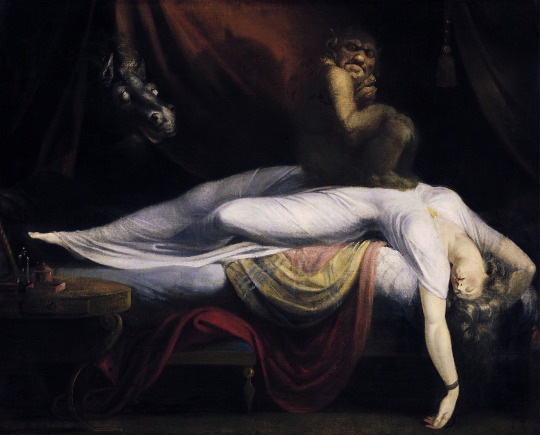
John Henry Fuseli - The Nightmare (1781)
Music of the 1760s-1790s, corresponding with the first wave of “Gothic Novels” in the English language. Some names in this era include Horace Walpole (The Castle of Otranto), Ann Radcliffe (The Mysteries of Udolpho, The Italian) and Charles Brockden Brown (Wieland). The closest we have to music of this same era would be in the Sturm und Drang style. Sturm und Drang (Storm and Stress) was used to describe music written in a minor key that was restless, agitated, intense, emotional, and more extreme than the typical expectations for restraint and lightness/clarity, music that aristocrats in powdered wigs and velvet and lace could relax with. Strong changes of emotion and more emphasis on subjectivity, reflected by sudden modulations and pulsing rhythms.
The most famous piece that I associate with Sturm und Drang is Wolfgang Amadeus Mozart’s “little” g minor Symphony no.25, K.183 (1773). It is famously used in the opening of Miloš Forman’s Amadeus (1984). It is a fun piece, and that opening movement is full of fire, and probably the young Mozart having fun (he wrote it at 17. If you ever want to lower your self esteem, look up what music Mozart wrote at your current age.). Another major work would be Joseph Haydn’s “Farewell” Symphony no.45 (1772), written in the very unusual for the time key of f# minor. And of course, even though he comes later, anything Ludwig van Beethoven published in a minor key has a lot of muscular passion to it, and his early/classical era of the 1790s is no joke. Check out the final movements of his Piano Trio no.3 in c minor and his Piano Sonata no.1 in f minor, or his most famous early sonata, the Pathetique.
But if the Sturm und Drang style and Gothic genre also emphasize the disturbed and the psychological, we can include programmatic works that do the same. Mozart’s opera Don Giovanni (1788) has an incredible moment in the finale. The sociopathic hedonist is confronted by the ghost of the man he murdered in the first act, who possesses a statue and confronts Don Giovanni with his sins. Don Giovanni doesn’t repent, so he is dragged into hell with a chorus of demons. Always a good reminder that Mozart wasn’t the eternal child who wrote pretty melodies.
19th Century

Caspar David Friedrich - The Abbey in the Oakwood (1810)
Music of the early 19th century corresponds better with Gothic fiction because Romanticism in art brought greater interest in the supernatural, in the subjective, in emotional reactions to the universe… major names in fiction include the poetry of Lord Byron (Darkness), Mary Shelley (Frankenstein, The Last Man), and Sir Walter Scott (The Bride of Lammermoor). Greater emphasis is put on the anxiety of the unknown, supernatural fears beyond our control.
Of all Franz Schubert’s songs, Erlkönig (1815) best exemplifies the Gothic (and this is a bold claim because I only know about a fraction of Schubert’s extensive song output). In it, a father and son are riding on horseback. The son is sick with fever. As they ride, the son cries out that he can hear the Elf King calling out to him, some evil spirit or demon that wants to take the son’s life. The father tries to calm him down, but the Elf King gets closer and closer. By the time they reach home, the son has died. Was the Elf King real? Was the son hallucinating from fever? How literal should we take this text? The ambiguity of subjective experiences and how we interpret and understand reality is a major theme in Gothic fiction.
Many famous German operas lean into the supernatural and magical. In this period we get Carl Maria von Weber’s Der Freischütz (1821), considered to be the first Romantic opera. In it, our main character Max who needs to win a shooting contest so he can be allowed to marry his lover, Agathe. He is given a gun that can shoot magic bullets by another forrester Kaspar (who has his own plans). Kaspar tells Max to meet him in the “Wolf’s Glenn” in the woods at midnight for more magic bullets. In the Wolf’s Glenn, Kaspar calls for a spirit, the Black Huntsman Samiel, to help him curse the other characters, offering Max’s soul in exchange. Making deals with demons/the devil was another fascination in Romanticism.
Legends of a diabolical nature were springing around great musicians. At the end of the 1700s, Giuseppe Tartini wrote his most famous composition, the “Devil’s Trill” Violin Sonata in g minor which is full of virtuosic passages. Tartini claimed that the Devil appeared to him in a dream, and that he sold his soul in exchange for the Devil to be his servant. He handed the Devil his violin, and the Devil “…played with such great art and intelligence, as I had never even conceived in my boldest flights of fantasy. I felt enraptured, transported, enchanted: my breath failed me, and I awoke” Source
Similar stories came about with violinist Niccolò Paganini, who astonished the audiences of the early 19th century with his (for the time) otherworldly technique, dazzling them with scales and leaps and scratches the likes of which you can hear across his 24 Caprices for solo violin. A young Franz Liszt was at one of Paganini’s concerts and he was enthralled and inspired to become the “Paganini of the Piano”. He too would dazzle audiences with his percussive intensity, glittering arpeggios, and dreamy modulations to possess women with the spirits of hysteria and other dated misogynistic diseases. Cliche to say but before Bieber Fever, before Beatlemania, there was Lisztomania.
The sense of Faustian bargains comes through in the pieces Liszt wrote after Goethe’s Faust. The Faust Symphony (1857) includes a movement for Mephistopheles, the demon/ the Devil that bargains with Faust. The Mephistopheles movement has no original theme, but takes and corrupts the themes of Faust and his lover Gretchen into a mocking tone. Later on, Liszt was inspired to write a tone poem “The Dance in the Village Inn” or Mephisto Waltz no.1 (c.1862). He also wrote it for piano around the same time. The story has Mephistopheles taking Faust to a wedding in a village and playing the violin so madly, the partygoers are intoxicated by the music and go off dancing in the woods. Emotions taking over and making one act irrationally was another fascination in Gothic fiction.
Liszt would go on in his later years writing a few more Mephisto waltzes, with a lot of forward thinking harmonies and piano writing, unfortunately not as popular. Mephisto waltz no.2 (1881) has moments that make me think of Debussy, and the third (1883) has glittering and ethereal moments. But the best example of Liszt’s interest in the Gothic would be his earlier concert piece Totentanz (1949), or Dance of Death (Danse macabre). In it, the piano and orchestra play out variations on the Medieval chant Dies Irae, always reminding us of the inevitability of death. The variations depict skeletons dancing wildly all while the Mephistopheles at the piano unleashes his seductive tones.
The Dies Irae chant goes across our pop culture, with one famous iteration being a synthesized version of passages from Hector Berlioz’s Symphonie fantastique that Wendy Carlos wrote for Stanley Kubrick’s The Shining (1980) after Stephen King’s novel of the same name. And it was Berlioz’s symphony that enchanted audiences in 1830 with new, titanic sounds beyond what orchestra music had been before. In the story of the Symphonie fantastique, an artist has tried to overdose on opium after feeling rejected by unrequited love, but instead he has a vivid drug induced nightmare where he is sentenced to be beheaded via guillotine, which was still a traumatic living memory for the Parisian audience. He then sees himself among ghosts and monsters during a witches’ sabbath, the lovely woman’s beautiful theme is distorted into a grotesque mockery, the Dies Irae comes back among the cackling. It was a new degree of imagination expected from the audience. Later, Berlioz would depict demons in Pandæmonium (the Capital of Hell in Dante’s Inferno) at the end of his Damnation of Faust.
Through the mid to late 19th century we get authors of Gothic literature such as Edgar Allan Poe, Elizabeth Gaskell, Emily and Charlotte Brontë, Nathaniel Hawethorne, and Victor Hugo. We also get two more operas that have Gothic themes. First is Richard Wagner’s The Flying Dutchman (1843). In this opera, a ship on the North Sea collides with the Ghost Ship of the Flying Dutchman who is cursed to sail the seas forever, but is allowed to come ashore once every seven years and if he can find a wife, he will be freed. I’m sure you can guess how this opera ends. The overture is often played in concert for a condensed version of Wagnarian thunder and romance. The next important opera is Giuseppe Verdi’s Macbeth (1847), because Shakespeare was being revived and translated in different languages across Europe and Verdi loved his plays. In the opera, Macbeth comes across a chorus of witches that foretell his success and downfall. He is too ambitious and goaded by Lady Macbeth, plans to take the throne through deception and murder. Lady Macbeth is later haunted with phantom blood on her hands which only she can see. And Macbeth succumbs to his inevitable fate.
We also get two significantly “Gothic” pieces of orchestra music. They are both tone poems, which also reflects the concert goers’ tastes. The one that has always been a quintessential “Halloween classical” piece is Camille Saint-Saens’ Danse Macabre (1875), opening at the stroke of midnight (softly evoked by the harp), a violin shrieks out the tritone (the “Devil’s interval” which the Romantics thought meant was cursed by the superstitious Medievals, really it was an idiom for “hard to use in music”) and introduces ballroom music along with the clacking bones of skeletons dancing in the graveyard (evoked by the xylophone). The skeletons dance through the night until the rooster crows at dawn.
The other great Halloween concert piece is Modest Mussorgsky’s Night on Bald Mountain (1867) which depicts another witches sabbath, this time on St. John’s Night, a major holiday in Slavic Eastern Orthodox culture. Walt Disney’s Fantasia (1940) would help bring this poem to life with an animated phantasmagoria of ghouls and skeletal horses and other demons flying around the mountainous demon Chernoberg.
[Here I want to give a quick shoutout to Cesar Franck’s Le Chasseur maudit (The Accursed Huntsman), a tone poem about a Count who doesn’t go to church one Sunday, and instead rides around to whip peasants for his own amusement, so demons drag him to hell. Not nearly as famous a concert piece as the others mentioned in this list but it has colorful orchestration so you should check it out.]
The initial idea for Fantasia was for Disney to repopularize Mickey Mouse by writing him into an animated version of Paul Dukas’ The Sorcerer’s Apprentice. The original poem by Goethe was a classic that Paul Dukas set to music in 1897. In it, we hear the Sorcerer leave his Apprentice to clean the floors of his workshop. The Apprentice uses magic to bring a broom to life so it can do the chores for him. The Broom mindlessly pours buckets of water all over the floor, and the Apprentice isn’t good enough with magic to stop it. He chops it up into pieces with an ax, but they regenerate into several brooms which go back to marching water in. The Sorcerer returns to clean the mess and scolds his Apprentice. This charming tale has a darker and more diabolically fun tone in Dukas orchestra.
20th Century
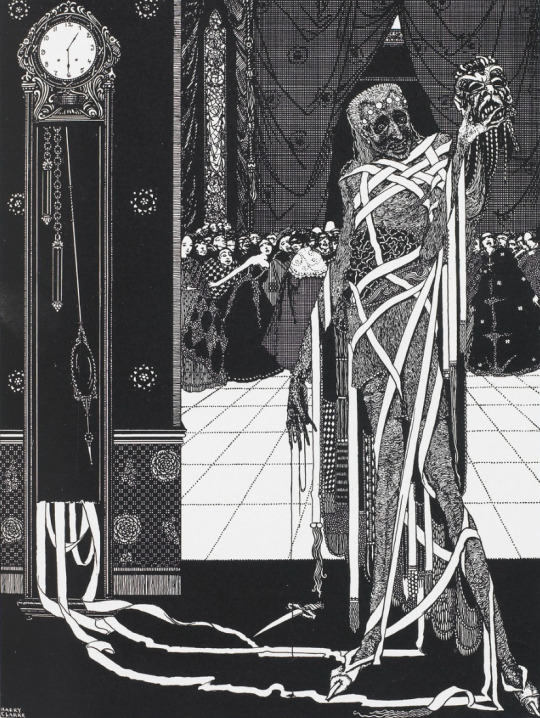
Harry Clarke - Illustration for "Masque of the Red Death" (1919)
In the same exact year of Dukas’ tone poem, we get Bram Stoker’s Dracula. At this turn of the century other major names include Gaston Luroux (The Phantom of the Opera), Robert Lewis Stevenson (Dr. Jekyll and Mr. Hyde), Henry James (The Turn of the Screw), Oscar Wilde (The Picture of Dorian Gray). At this time, there are a few more pieces that continue trying to evoke Gothic subject matter. One comes from Gustav Mahler’s Symphony no.7 (1905), sometimes dubbed “Song of the Night”. Two of the symphonies five movements are titled “Nachtmusik” (night music), the first is more in line with Gothic anxiety and spookiness than the second which is more like a serenade. But the most Gothic movement is the Scherzo which sits in the middle of the symphony and is like a Viennese ballroom full of dancing corpses and skeletons as waltz music decays with them.
A surprising example (at least, because of how relatively obscure it is) comes from Claude Debussy with parts of an opera based on Poe’s The Fall of the House of Usher that he worked on between 1908-1917. Not too much a surprise on the one hand because French translations of Poe’s work became popular and influential. On the other hand Debussy is more known for evocative sound pictures, unique musical colors, and subtlety. Perhaps he was drawn to symbolist and psychosexual interpretations of The House of Usher, the same interests that preoccupied him with his only finished opera Pelleas et Melisande. Roger Orledge reconstructed the opera and tried to stay true to Debussy’s style, so what we do have is passable and as shadowy and vague as his other orchestral masterpieces.
Maybe the hardest work to recommend (but I do recommend regardless, give it a chance) is a Modernist song cycle for chamber ensemble. Arnold Schoenberg’s Pierrot Lunaire (1910) uses freely chromatic atonality to give a demented color of psychosis experienced by Pierrot, personified version of a stock character for old Commedia dell Arte plays, a clown who over time became the “sad clown”. Maybe a precursor to the demon from Stephen King’s It, or the demented clowns and jesters that laugh at the madness of the cosmos across Thomas Ligotti’s short stories.
This was only meant to be a small overview of works that could fit my own view of the Gothic in music. There are more examples I could include, so as a hint toward today, I’ll end with a piece that was written about a century ago, yet sounds as if it could have been written today. Henry Cowell’s The Banshee (1925) is a short piano piece, so if you can, at least listen to this one. Instead of playing with the keys like you’re “supposed to”, Cowell asks the performer to drag their fingers along the wires directly. This creates disturbing reverberations and scratching sounds that tingle the back of your neck, that feel like the otherworldly cry of a Banshee.
Happy Halloween.
#classical music#Halloween classical#Halloween#Halloween music#Mozart#Haydn#Beethoven#Schubert#Liszt#Paganini#Berlioz#Saint-Saens#Mussorgsky#Wagner#Verdi#Dukas#Mahler#Debussy#Schoenberg#Cowell#Wolfgang Amadeus Mozart#Josef Haydn#Ludwig van Beethoven#Franz Schubert#Niccolo Paganini#Franz Liszt#Hector Berlioz#Camille Saint-Saens#Cesar Franck#Franck
107 notes
·
View notes
Text

Day 183 is small Grian pictures
Okay, guys, just hear me out. Let's think about French Grian
CC!Grian can speak French, according to Phasmophobia videos. But what if we will think, that C!Grian Is really French, like imagine
Parrot Grian sitting on the tree and eating baguette
150 notes
·
View notes
Text
Intro
🥀 Em
🥀 28
🥀 Minors DNI
🥀 SW: 228.2
🥀 CW: 199
🥀 GW1: 199 ✅
🥀 GW2: 183
🥀 GW2: 168
🥀 GW3: 140
🥀 UGW: 129
🥀 I recovered for around 9 years.
🥀 Diagnosed B1pol4r, C-PT5D & 8PD
🥀 Recovering alcoholic. 5 years sober.
🪽Pro-recovery for everyone else. You are beautiful. You are worthy. You are enough 🪽
‼️ Don’t come here expecting to see f4t5p0. I will never drag down another woman. ‼️
Also. I talk about my pets a lot. This is Barney. Barney loves you and Barney wants you to be healthy and safe

This is Goose

This is Bacon

This is Pancake (he’s new here)

This is Egg the wanderer. She escaped for 3 weeks and flew 60+ miles. Shes home now, safe and well.

This is Kiwi. She’s my husbands parrot and she’s mean as hell.

This is Hank. He’s practically a cryptid that we only see when the stars align.

41 notes
·
View notes
Text
Masterlist of Vetted Fundraisers from the Palestinians who directly contacted me (5-9 October)
9 October
Myassar Ramadan (@mya-ram): Myassar is a 33-year-old aspiring dentist. She has 3 children under 12. She has lost friends and families. She is fundraising to provide for daily necessities, to rebuild, and resume her studies. (https://gofund.me/07640856) (#134 on @/gazavetters vetted list) (€30 raised of €100,000 goal)
Hala, Ali Elshurafi (@halamahmoud66, @sohaabdullah73): This campaign raises funds for two sisters and a brother who wish to evacuate out of Gaza. The sisters are high school students while the brother is a uni student. (https://gofund.me/b20496e1) (vetted by 90-ghost) (£441 raised of £30,000 goal)
8 October
Yahya Bkheet (@yahyabkheet-blog): Yahya is 33 years old and has 3 children all under the age of 10: Dima, Mira, and Anas. He has a sick mother. Their house has been destroyed and they have been displaced more than 10 times. (https://gofund.me/6b7be7a8) (vetted by nabulsi, #110 on @/gazavetters vetted list)
Ahmed Sadeq (@ahmed94sadeq,@hadeeladly97): Ahmed and his partner Hadeel were supposed to get married in December 2023. They have lost their house. They managed to evacuate to Egypt with Hadeel’s elderly parents who suffer from chronic diseases. He is fundraising to evacuate the rest of his family in Al-Mawasi, Gaza, as well as provide for basic needs. (https://gofund.me/f8792ac4) (shared by 90-ghost) (€116 raised of €70,000 goal)
Akram Aldwake (@akramaldwaik18): Akram is 18 years old. He is from a family of 5 and has a twin brother called Malek. Their house has been bombed and their 12-year-old cousin was killed. They had to dig their mother, sister, and one-year-old niece from under the rubble. Many of his relatives have been killed. Akram wish to evacuate himeself and his family out of Gaza and continue his education. (https://gofund.me/1494903b) (#138 on @/gazavetters vetted list) ($65 USD raised of $25,000 goal)
Hossam Muhammad Abu Sakran (@hosam2004): Hossam is from a family of 7. His 80-year-old grandfather was killed by a sniper. Their house has been bombed. They are now displaced in Deir al-Balah. (https://gofund.me/dec9ba4c) (#131 on @/gazavetters vetted list)
Amal Al-Haj (@amal-alhaj): Amal (28) and her husband Abdel have 2 children: Roland (6) and Omar (2). Amal has lost her father due to a delay in medical treatment. Her mother suffers from high blood pressure and arthritis. Amal also has 4 younger siblings: Abdullah (21), Rana (18), Hala (13) and Mahmoud (14). They wish to evacuate out of Gaza. (https://whydonate.com/en/fundraising/save-amal-and-abdel-nassers-family-in-gaza) (#135 on @/gazavetters vetted list, shared by @/bilal-salah0) ($114 of $15,000)
Ismail (fadingchildwitch): Ismail is a photojournalist. He is raising money to buy basic necessities (tent, food, water, medical care) for himself and his family. (https://chuffed.org/project/114849-ismails-urgent-plea, https://www.paypal.com/pools/c/98D6XwUY4x) (#7 on this @/gaza-evacuation-funds vetted fundraiser post) (€5 raised of $10,000 on Paypal, and $67 raised of $18,000 on Chuffed)
Aisha (@mostafa-4, @mostaf77): Aisha has 4 children. She is a a 45-year-old mother with diabetes and high blood pressure while her husband Mustafa cannot walk. Their eldest son (22) is a computer engineering student, her eldest daughter in high school, while their two youngest children are in primary school. (https://gofund.me/025e9fee) (#340 on vetted fundraiser list by el-shab-hussein and nabulsi, also vetted by association. Mustafa is the brother of @/noor4habil8 (#5 on @/gaza-evacuation-funds vetted list here)) (€183 raised of €50,000 target)
Abdelrahman Alostaz (@3bdulra7manosama): Abdulrahman was a uni student studying medicine. He wishes to complete his educationin Egypt and help his family in Gaza. (https://gofund.me/e71b85a4) (#4 on @/gaza-evacuation-funds vetted list here) (€1,850 raised of €30,000 goal)
Shadia Al-Habil (@shadiafamily): Shadia is 25 years old. She graduated with a degree in English and was working as a teacher while completing her master’s degree. Her younger brother Mohammed (17) and sister Rama (13) both contacted hepatitis. She is also living with her sister’s family, including their 2-year-old son. (https://gofund.me/96181c05) (vetted by @/moayesh (vetter for @/gaza-evacuation-funds), promoted by @/gaza-evacuation-funds) (€1,030 raised of €70,000 goal)
7 October
Marah (@marahxx, marah-xx): Marah is married.40 members of her family have been killed in a bombing that destroyed her house. Her family now consists of 7 adults and 3 children. They wish to evacuate out of Gaza. (https://gofund.me/fea514fc) (shared by @/bilal-salah0 (#132 on the verified fundraiser spreadsheet vetted by el-shab-hussein and nabulsi))
Nour Abuelreesh & Mohammed Al-Madani (@nour-gaza): Nour and Mohammed have 2 daughters, the oldest is barely 2 years old and the youngest only a few months old. They are fundraising to buy basic necessities like food, and to eventually rebuild. (https://gofund.me/397145df) (vetted by association as Nour is a sister of @/hamza-gaza (vetted by @/gazavetters and #91 on their vetted list, also vetted by association)) (kr14,695 SEK raised of kr500,000 target)
6 October
Mohammad Ayesh & Yasser Ayesh (@ayeshjourney, @moayesh): Yasser was born in the 2014 war and became hard of hearing due to the sound of missiles. He has undergone a cochlear implant operation. The device implanted has to be charged regularly, Yasser now goes for days without hearing because he is unable to charge the device. As a result, Yasser has been losing the ability to pronounce some words. Mohammed is raising money to repair Yasser's hearing device, for Yasser's speech therapy, and also to rebuild their family home. (https://gofund.me/649fd2d9) (This is Mohammad Ayesh’s family’s campaign, he is one of the vetters at @/gaza-evacuation-funds!) (£1,250 raised of £60,000 goal!)
Samah (@samah-h): Samah and her husband have two daughters (age 9 and 2), as well as a 6-month-old baby born during the war. Samah gave birth without anesthesia or medical supplies. Her husband is also responsible for his 3 siblings, one of whom also has a child. They wish to evacuate out of Gaza. (https://gofund.me/c2ab5e0c) (vetted by association/ vetted by @/bilal-salah0! They are the relatives of @bilal-salah0 (#132 on the verified fundraiser spreadsheet vetted by el-shab-hussein and nabulsi)) (€649 raised of €80,000 goal!)
Khalil Halas (@khalil-92): Khalil’s family consists of 12 members. While displaced, the Israel army killed his mother and arrested his younger brother. His brothers Muayad and Muhammad are both seriously injured and require surgeries. Their home has been destroyed. They are fundraising to buy basic necessities and to evacuate out of Gaza. (https://gofund.me/42a958e3) (vetted by association! Khalil is a relative of @/salman-1990 (vetted by 90-ghost) and a tent neighbour of @/sara-97a (vetted by 90-ghost)) (€371 raised of €30,000 goal)
Mohammed Alhabil (@mohammed-blogs): Mohammed’s father and brother have been martyred. He has been injured in the bombing that killed his brother Omar, and may lose his leg forever. He wishes to evacuate out of Gaza to get the medical treatment he needs. (https://gofund.me/34639589) (vetted by association! Muhammad is the brother of @nohaibrahim-blog (#157 on verified fundraiser list by el-shab-hussein and nabulsi, and #169 and Butterfly Effect Project vetted list)) (€642 raised of €20,000 goal!)
Mahdi Jad Al-Haq (@moh26, @moh26666): Mahdi and his wife Elham have 3 children: Saeed (19), Ahlam (22) and Sherin (15). Their house has been bombed and they wish to evacuate out of Gaza. (https://gofund.me/94a9652c) (vetted by 90-ghost, vetted by @/gazavetters and #72 on their vetted list) (kr6,988 SEK raised of kr300,000 goal)
Iman Shaban (@transparentobjectlady): Iman has 5 children, the oldest is 15 and the youngest only 2. The children are suffering from malnutrition and scabies. They are fundraising to buy basic necessities. (https://gofund.me/17ef495a) (#31 on @/gazavetters vetted list!) ($268 CAD raised of $50,000 goal)
5 October
Jana Abunaji (@janaabunaje): Jana is 11 years old and she has 2 younger brother ages 9 and 5. Their father was injured at the beginning of this war, putting him out of job. They are strugglign financially, and things are so bad her parents are getting a divorce. They have no water, support or medical care. (https://gofund.me/b7408ba3) (vetted by association! Jana is the niece of @ahmedmatatsblog (vetted by @/gazavetters and is #33 on their Gaza vetted fundraisers list)) (€36 raised of €50,000 target)
Hala Dawoud (@halakamak): Hala have 3 children: Osama (17), Lana (13) and Mohammed (9). Hala suffers from a severe and chronic disease called multiple sclerosis (MS) which affects his ability to stand and walk. The treatment she needs is not available in Gaza, and if she doesn’t get the treatment it can cause nerve damage and permanent disability as well as loss of bladder control and vision impairment. She needs to evacuate out of Gaza to get treatment! (https://gofund.me/61e85243) (#307 on the vetted fundraiser list by el-shab-hussein and nabulsi, #954 on Butterfly Effect Project vetted list!)
Asma El-Derawi (@asmadirsblog): Asma is a Medical Laboratory Technologist. She is from a family of 15, including 6 children, the eldest of whom is 10 years old while the youngest is only 2 years old. Her brother Mohammed (24) is a uni IT student while her brother Ahmed (18) is a high school student, both of whom have been prevented from graduating. Her 2 sisters have 6 kids in total: Hazar (10), Tala (8), Mohammed (5), Hayam (6) years, Ibrahim (2), Noor (2). They wish to evacuate. (https://gofund.me/bebe3734) (vetted by el-shab-hussein and is #220 on vetted fundraiser list by el-shab-hussein and nabulsi)
Jaber Al-Haj (@jaberfamily, @jaberhj): Jaber is an Applied Chemistry graduate. He is currently in Kuwait but his wife Muna and his 2-year-old son Hashem are trapped in Gaza. He is fundraising to bring his family to Kuwait and to rebuild the business he had with his brother Aboud. (https://gofund.me/cc2a0f13) (shared by 90-ghost. Also vetted by association. He is a friend of @/osama--basil-sh (Shared by 90-ghost. Also Vetted by association)) ($110 USD raised of $29,000 goal!)
Mounir Alanqar (@shamraed): Mounir is 19 years old and from a family of 7. She has 4 siblings: Rasha (22 and married), Rana (21 and married), Mohammed (16), and Sham (4). Her mother suffers from chronic asthma and does not have the medication she needs. Sham is suffering from skin rashes, diarrhea and vomiting because of the contaminated water. They wish to evacuate out of Gaza. (https://gofund.me/296390e2) (#8 on the @/gazavetters vetted list) (€1,656 raised of €35,000 goal)
Click here for my Google Doc with my complete masterlist of all the Palestinian gfm asks I've received, updated daily (along with other verified ways to send aid to Gaza).
How are gfm campaigns vetted? See here, here, here and here.
See post here for other verified ways to send aid to Gaza.
Don't forget your Daily Clicks on Arab.org, it's free!!! and Every click made is registered in their system and generates donation from sponsors/advertisers.
#queued post#palestine#gaza#free gaza#free palestine#post has been vetted and verified#verified#gaza genocide#vetted#donations#fundraising#vetted gfm#vetted campaign#vetted fundraisers#vetted gofundme#verified fundraiser#verified gofundme#gaza fundraiser#gaza gofundme#palestine gofundme#palestine fundraiser#gaza gfm#palestine gfm#masterlist#queued#5-9 September
96 notes
·
View notes
Text
I’m rereading the wild robot series with the intent of looking out for the smaller details and a particular one caught my eye in the first book that got me thinking about the exact time period the wild robot is set in

While it isn’t mentioned in the book what kind of turtle he is, based on the turtle we do see in the movie I believe he is a common snapping turtle (tho maybe a hybrid of some sort like brightbill is). Why is this important? To find the age range of his grandfather of course and what time frame the water levels suddenly rose!
C. Snappers (in northern ranges) mature at earliest around 15 years old. So if Crag’s father was one of his grandfather’s first kids, then -at youngest- the grandfather was 30 years old when Crag hatched. So the absolute latest the sea level could’ve occurred was about 123 years ago before the events of twr. But if the grandfather was in the upper ranges in age when Crag hatched (90-ish) then the absolute earliest the event occurred was 183 years ago.
But when specifically did this 123-183 range occur?
Well let’s turn to the third book, in which we’re given the age of the ancient shark!

.

Over 500
So 501-599 is our range here.
And going off her words, she would’ve seen things like galleons and sail powered merchant ships.
Doing a little research, America really started to get into whaling after the revolutionary war around 1783 which is close to when the first steam boat was built in 1813.
Using 1783 as our basis and adding the shark’s age range our time period that twr takes place in would be 2284-2382.
Minus the previous range with when the flood waters happened then the mountain turned into an island around 2101-2259!
Thank you for coming to my ted talk, I have thoughts that plague me!
31 notes
·
View notes
Note
Slimecicle approaching the speed of C for a funny bit

[#183] where the hell is he going
69 notes
·
View notes